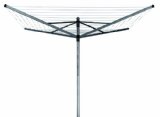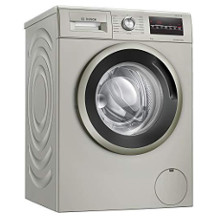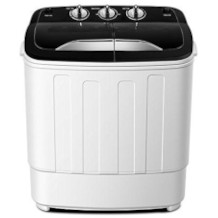Condenser tumble dryer purchasing advice: how to choose the right product
- The most important facts in brief
- A dryer removes moisture from laundry items using hot air.
- The moisture is condensed into a collection container.
- Condensing dryers are cheaper to buy than other types of dryers.
- On the other hand, they cause higher follow-up costs, especially in large households.
- They are therefore particularly suitable for single households and small families or shared flats.
Reasons for a dryer
In spring and summer, when temperatures are moderate to warm, laundry dries by the power of the sun and wind alone. This is environmentally friendly and good for the wallet at the same time. In other weather conditions, however, drying clothes outdoors takes much longer, and after a rain shower the drying clothes are immediately wet again. In addition, it also depends on the environmental conditions: Especially in big cities, not all households have a garden or a balcony, and accordingly not everyone has the opportunity to dry their laundry in the fresh air. In the home, a clothes horse takes up a lot of space and is often in the way. If the user does not ventilate sufficiently and properly, there is even a risk of mould forming on the walls due to moisture accumulating. The remedy is a tumble dryer. Compared to a fold-out clothes horse, it takes up less space and dries regardless of the weather. In addition, the drying process takes less time and users can put their favourite shirt back on more quickly. Another advantage that many people appreciate: After drying, the laundry is pleasantly fluffy instead of scratchy, and that without the use of fabric softeners.
Advantages of a tumble dryer
- Takes up less space than a clothes horse
- The laundry is dry again more quickly
- Not dependent on the weather
- There is no need to hang up the clothes
- Fluffy soft laundry even without fabric softener
How it works
Clothes dryers work most efficiently when the laundry has been pre-dried beforehand, for example by the spin programme of the washing machine, which already mechanically removes a large amount of water from the individual garments.
A condensation dryer, often abbreviated to a condenser tumble dryer, works with a largely closed air circuit. Here, the moist air from the laundry is not blown into the room air, but condensed by air cooling. As a result, the moisture returns to its liquid state and is collected in a container.
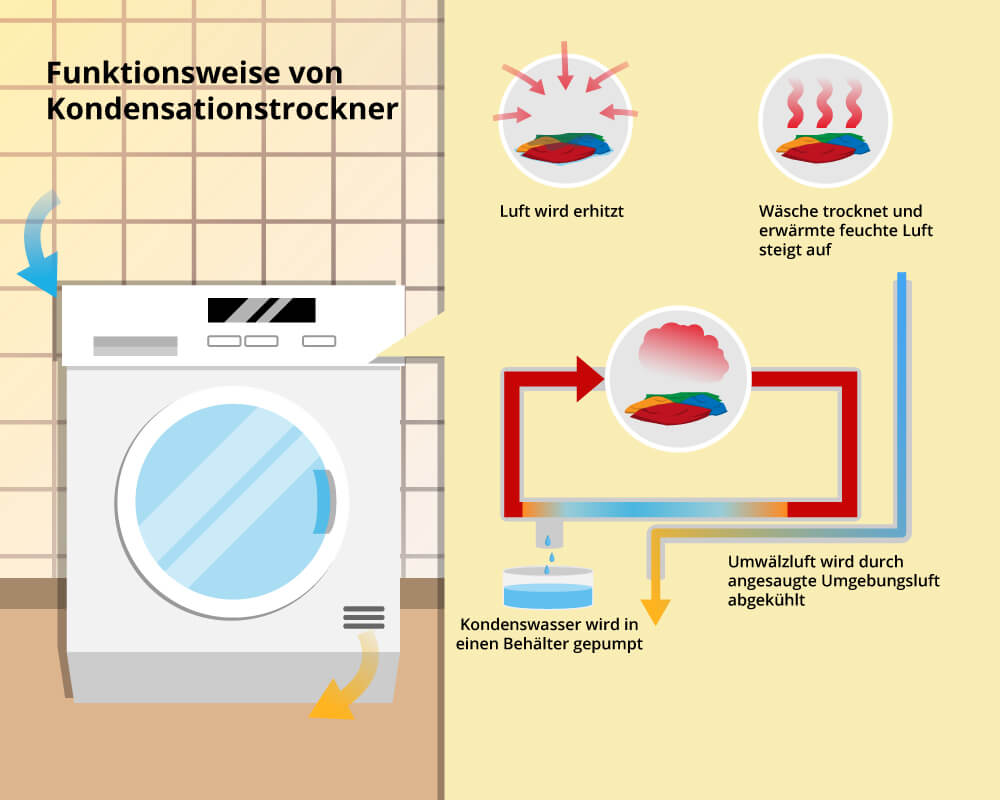
And it works like this: The initially cool circulating air is heated because warm air is able to absorb more moisture than cold air. Due to the comparatively higher steam pressure in warm air, moisture is extracted from the laundry. Evaporation effects ensure that the moisture in the clothes is absorbed by the air. A condenser located underneath the drum now draws in cool air from outside and extracts the moisture from the air surrounding the machine. The warm, humid air is dehumidified by the cool ambient air reducing the temperature of the warm, humid machine air in the condenser, which is spatially separated by metal sheets.
In the process, the temperature in the condenser falls below the dew point and the excess moisture previously stored in the warm air condenses as liquid water into a collection container. The circulating air that has been cooled down and dehumidified in this way is now reheated. This completes the cycle.
The ambient air used to cool the air flowing through the condenser is discharged back into the room. A condensation dryer thus makes use of the principle of air cooling to extract moisture.
Influence of the circulating air temperature
Since a condenser tumble dryer needs cool air to separate the moisture from the heated circulating air, the cooler the surrounding room air, the more efficiently the units work. Locations in the attic in summer or next to a switched-on radiator are therefore not recommended. In these cases, a condenser tumble dryer works less efficiently. It takes more time, consumes more energy and thus causes higher costs. A cool cellar room, on the other hand, is ideal.
Condensation water: Collection container or directly into the waste water?
The condensation water is usually pumped into a collection container, which users usually have to empty after about two to four dryer cycles. To do this, they remove the cassette, which is usually located at the front of the condenser dryer next to the control panel. It usually holds two to three litres of condensation water.
Regular checking after each drying cycle prevents inefficient drying and thus higher energy costs.
Some condensation dryers have an additional or exclusive connection for the waste water network, a so-called integrated condensation water drain. With such appliances, there is no need to empty the water tank.
Important purchase criteria
When deciding on a specific condensation dryer model, there are various factors that play a role in the choice. These include capacity, energy consumption or special programmes. We summarise the most important information.
Advantages and disadvantages of classic condenser tumble dryers
A classic condenser tumble dryer works without a heat pump, but with a heat exchanger, the condenser. Cold ambient air is drawn in and cools the moist air. Condensate accumulates. Warm exhaust air escapes unused into the room.
Advantages
- Can also be used in windowless rooms, as there is no exhaust air hose
- Comparatively short programme duration
- Lower purchase price compared to models with heat pump
Disadvantages
- Small rooms heat up strongly, so the process is less efficient and takes longer
- Energy costs higher compared to units with heat pumps
For which user group is a classic condensation dryer suitable?
Due to the increased energy consumption, a condensation dryer is particularly suitable for smaller households where the machine is not used so often. A condenser tumble dryer is also recommended for consumers who attach importance to their laundry drying quickly.
Capacity: How many people are in the household?
In addition to the question of which type of dryer is suitable for which households in terms of operating costs and programme run times, the drum size must also be considered. This determines whether the possible load is sufficient for a large family or whether there are waiting times during which wet laundry cannot be dried. On average, condenser dryers allow a load of six to eight kilograms. They are suitable for a two- to five-person household with a high laundry load. For smaller laundry loads, such as in single households, an appliance with a capacity of six to eight kilograms is sufficient. If the user has chosen the right drum size, he does not have to wait until enough laundry has accumulated, nor does he have to start a machine that is only half full. For large families or industry, maxi machines with a capacity of eight kilograms or more are a good choice.
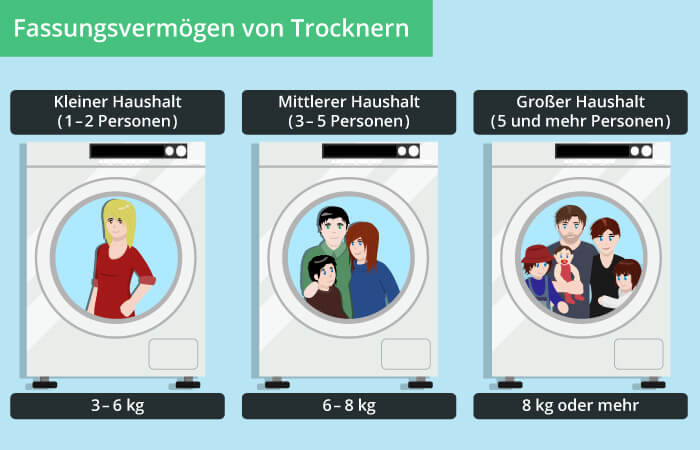
Design: front loader or top loader?
Like washing machines, there are front-loading and top-loading models. Front-loaders have the loading opening at the front, while top-loaders have a lid on the top through which the laundry is loaded. Theoretically, this means that users could place another appliance on top of a front-loading appliance, as this would leave the loading opening free. Front loaders offer the possibility of placing an appliance with similar dimensions on top of them, such as a second dryer. However, there is a weight limit here that does not allow washing machines to be placed on top, for example.
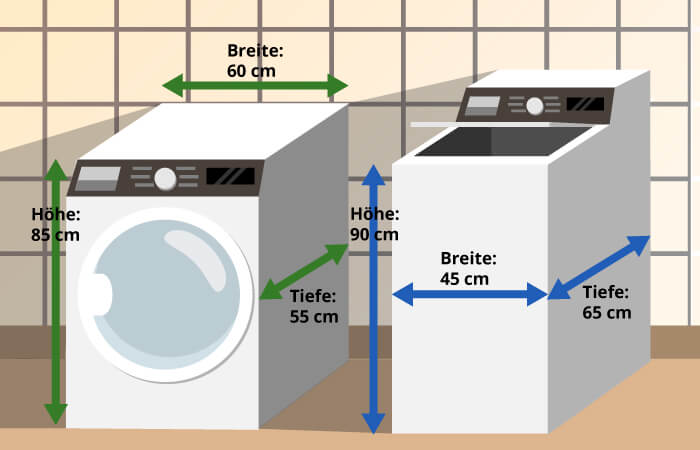
This option is out of the question for top loaders. The filling opening of the lower machine would be blocked and the top loader opening of the upper machine would no longer be accessible without a ladder.
Top loaders usually have a different design than front loaders. They have a smaller width and a greater depth. This is because the drum does not rotate clockwise or anticlockwise as in front loaders, but is offset by 90 degrees. This makes top-loaders attractive for rooms where space is limited. It should be noted, however, that the machines also protrude further into the room due to their greater overall depth. Top-loading dryers are not too widespread on the European market.
Type of installation: freestanding, column-mounted, under-counter
Condenser tumble dryers also differ in the way they are installed. We show what options are available here.
Freestanding dryers
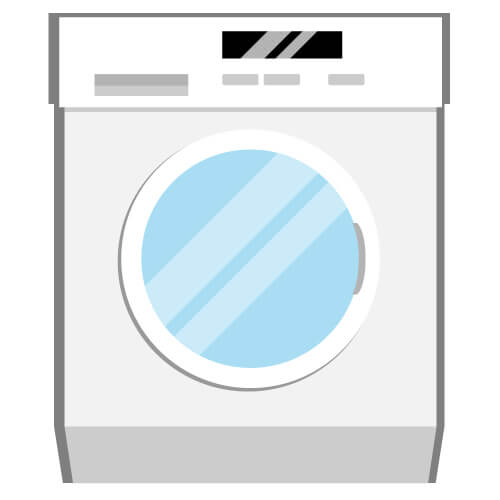
The best-selling appliances are free-standing condensation dryers. They require a comparatively large footprint and a power socket in the immediate vicinity. Apart from that, users are very flexible in their choice of location. Most of these appliances have a surface area of 60 x 60 centimetres and an overall height of 80 centimetres.
Column-mounted dryers
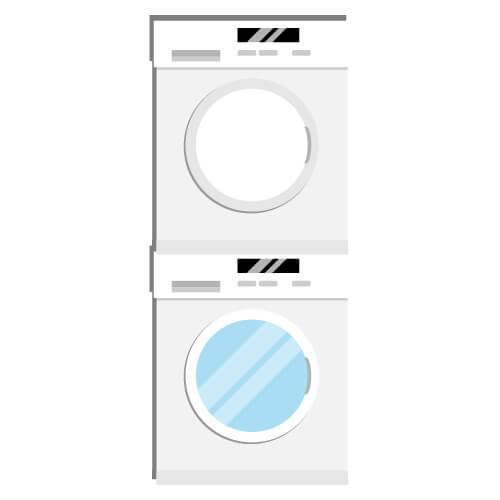
In many households, there is not enough space next to the washing machine to accommodate an additional dryer. A column-mounted dryer is ideal for this user group. This can be placed on top of the washing machine and thus utilises the height of the room. The footprint of the dryer must not be larger than that of the washing machine below. To ensure that both machines stand securely, manufacturers offer special connecting frames. With this type of installation, neither machine should be a top-loading model.
Under-counter dryers
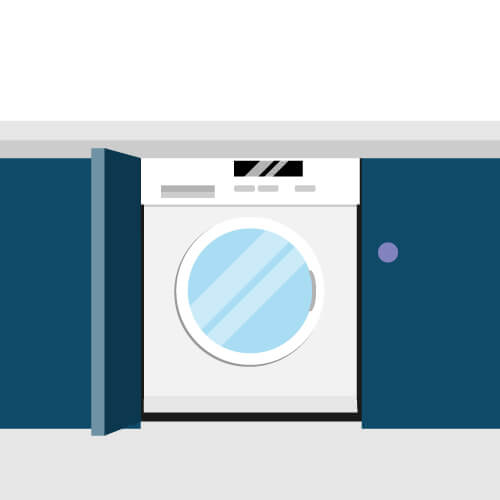
Under-counter dryers have the advantage that they can be integrated under the worktop in a kitchen, for example. This is particularly advantageous if there is enough space and the machine should not change the interior design. For installation, the cover plate of the condensation dryer is removed and replaced by a substructure plate.
Energy consumption: easy to compare thanks to uniform EU energy label
Since 2014, manufacturers of large electrical appliances such as dishwashers, freezers or dryers have been obliged to provide information on the energy efficiency of their appliances. These consumption values are summarised on a uniform label and can be easily viewed by those who are undecided. The values listed are intended to simplify the purchase decision.
| Efficiency class | A+++ | B | Old device (approx. 10 years) |
| Power consumption per drying cycle* | 1.5kWh | 3.0kWh | 4.2kWh |
| Electricity costs per dryer run** | 0.44 euros | 0.87 euros | 1.22 euros |
| Electricity consumption per year*** | 187.5kWh | 375kWh | 525kWh |
| Electricity costs per year**** | 54.38 euros | 108.75 euros | 152.25 euros |
| Electricity costs over 12 years | 652.56 euros | 1,305.00 euros | 1,827.00 euros |
The table shows that the purchase of a new appliance can pay for itself over several years. However, appliances with an A+++ label are currently only found in heat pump dryers. Condenser tumble dryers achieve efficiency class B at most. Nevertheless, due to the still high purchase price, heat pump models are recommended above all for large families of five or more people, as the higher price otherwise only pays for itself after a long period of operation. For users who use the appliance only irregularly and for correspondingly fewer people, buying a condenser tumble dryer may be the better choice.
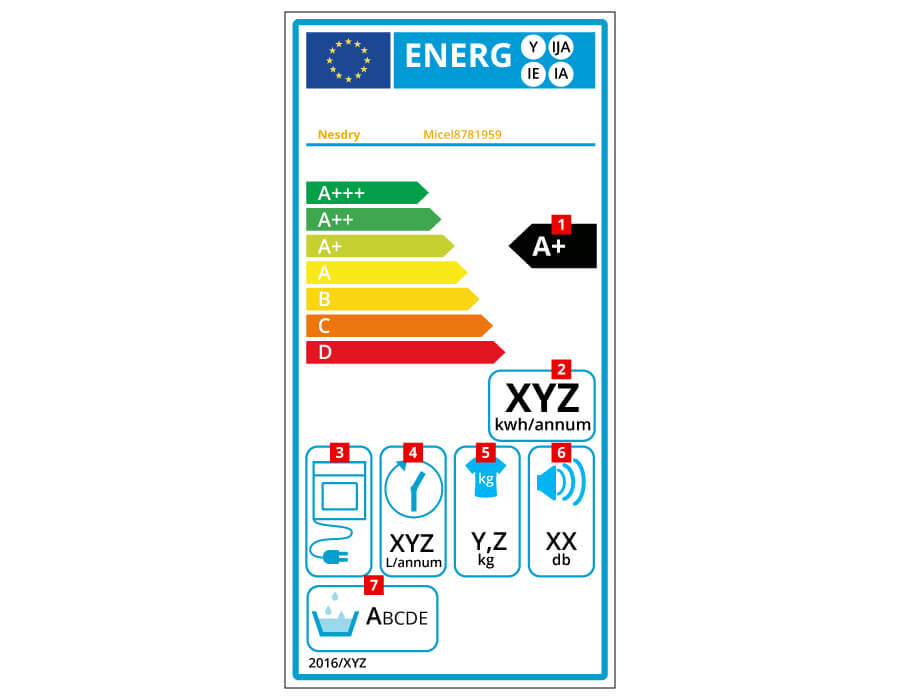
On the top (1), interested parties will find the manufacturer’s name and the model designation. The other details are explained below.
2) The energy efficiency class
Like other large electrical appliances, tumble dryers are assigned to seven different energy efficiency classes. The current best class with the lowest average consumption is class A+++, shown in green, while the class with the worst consumption values is called D and is shown in red.
How is this index calculated?
The classification into an energy efficiency class is based on the following test values:
– Energy consumption of the standard cotton programme at full load.
– Energy consumption of the standard cotton programme with partial load
– Energy consumption when switched on
– Energy consumption in stand-by mode
Since the end of 2015, appliances in efficiency classes C and D are no longer available. Efficiency class B therefore now represents the minimum standard for tumble dryers. Since the label is regularly rescaled, it is possible that the A+++ specification will soon no longer be the standard.
3) Power consumption
Below the bars for the energy efficiency class, users will find the average annual electricity consumption of the appliance, given in kilowatt hours. The calculation is based on 160 runs of the standard cotton programme at full load and at partial load. The appliance must dry the laundry from an initial residual moisture of 60 percent, as it comes out of the washing machine, down to zero percent residual moisture.
Caution: Consumption values may vary
Users should note that these tests are carried out under laboratory conditions. Depending on the washing machine, the initial moisture content may vary. In addition, the price of electricity varies by region and provider.
4) The appliance type
This information reveals what type of dryer it is:
- Exhaust air dryer
- Condenser tumble dryer
- Gas-powered dryer (not very common in Germany)
Consumers cannot tell from the energy label whether the condenser tumble dryer is a model with or without a heat pump. However, the average energy consumption under point 2 gives an indication.
5) Duration of the drying process
This information refers to the duration of a standard drying process in the cotton programme. The dehumidification from 60 to zero percent is measured. Condenser tumble dryers are about 30 to 60 minutes faster.
6) Maximum load
This item indicates the maximum amount of laundry that can be put into the machine at 60 percent residual moisture in the standard programme.
7) Operating volume
The operating volume of the machine can also contribute to the purchase decision: While this factor does not play a major role in large households where the dryer is located in the basement, for example, the noise level is definitely important for users where the machine is operated in the kitchen or bathroom, for example. On average, condenser dryers cause noise emissions of 65 decibels. Values between 60 and 65 decibels are considered quiet. However, some models reach 80 decibels and more.
Decibel
Among other things, loudness is expressed in the sound pressure level unit decibel (dB). A television set at room volume produces about 60 dB. An increase in this level by 10 dB points is perceived by the human ear as twice as loud. An 80 dB emitting device is perceived by the user as four times as loud. This corresponds to the operating noise of an electric lawn mower.
8) The condensing efficiency class
Consumers will only find this information for condenser dryers, regardless of whether the model has a heat pump. There are seven condensing efficiency classes, ranging from A to G, with A being the most efficient class. The class results from the ratio of the condensation water collected in the tank and the water extracted from the laundry. For technical reasons, it is not possible to collect 100% of the condensed water in the container provided for this purpose. A certain proportion is therefore always released into the ambient air. The smaller this proportion, the better.
Drying programmes and functions
Condenser tumble dryers from various manufacturers, whether AEG, Beko, Bauknecht, Gorenje, Bosch, Siemens or Miele – they all offer a selection of standard and extra programmes that users can choose from depending on the type of textile or the time available. For example, there are special wool or silk programmes that are very gentle on laundry. In addition to the standard cotton programme, there are special programmes for gently drying shirts, jeans, sportswear or bed linen. A short programme is, as its name suggests, particularly practical when things have to be done quickly. Less delicate textiles are then ready to wear within 30 to 45 minutes. Some condenser dryers also have programmes for removing lint, airing or smoothing laundry.
Users can manually adjust the dryness level via a rotary dial. Most machines distinguish between:
- Ironing damp: about 60 minutes running time. The right choice if the laundry is to be ironed afterwards. The laundry is still a little soggy and ironing is easier.
- Cupboard dry: about 75 minutes. This programme is suitable if the laundry is folded directly into the cupboard. The minimal residual moisture is not a problem here.
- Extra dry: about 95 minutes running time. In this programme, the laundry is left to dry and can then be worn directly.
Special features: Useful extras
In addition to the special programmes described, some machines have other useful features such as crease protection or start time setting. We present the most important functions.
Crease protection

Crease protection is a practical feature for those who tend to forget their laundry in the dryer, or who want to turn on the machine even though they are not at home at the end of the programme. If they do not remove the laundry immediately after the end of the programme, the appliance automatically switches to this mode and loosens the clothes by rotating them slowly. This prevents creasing.
Automatic cycle
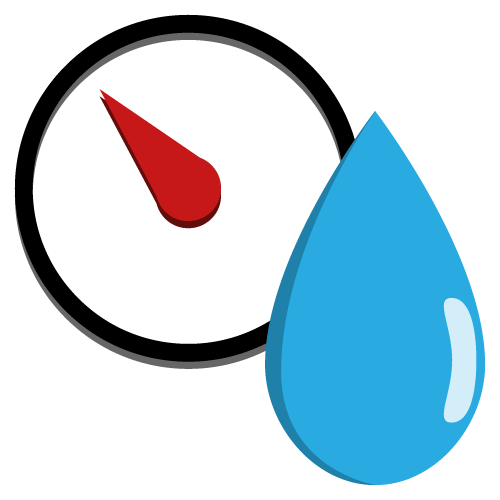
Some people are familiar with the automatic cycle mode from washing machines: Here, moisture and temperature sensors automatically adjust the running time and energy consumption of the current programme to the amount of laundry and residual moisture. In this way, they help to save water and electricity – without users having to do anything.
Start or end time preselection

With the “start or end time preselection” feature, users set a time at which a programme should start or be finished. In our opinion, however, this function is more suitable for washing machines or washer-dryers: With it, users can specify that the washing programme is ready exactly when they get home from work, for example. This prevents an unpleasant smell of laundry standing in water. A dryer, on the other hand, can be switched on directly. Thanks to the crease protection, users can also remove the laundry later.
Display

Most condenser dryers have an LC display. It shows the selected programme and the remaining time. This lets users know when their laundry is ready. Some models indicate visually and acoustically necessary steps such as emptying the condensation tank or the lint filter.
Drum lamp
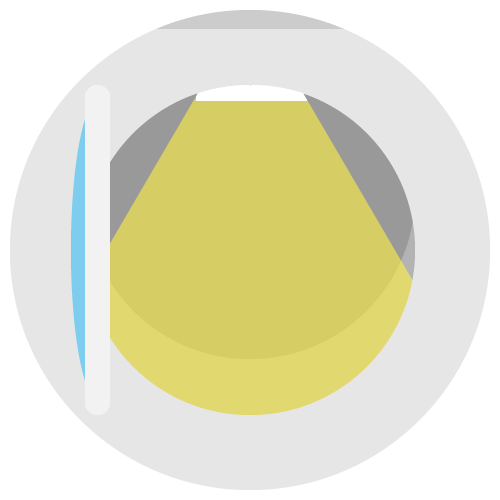
Some models have an illuminated drum, usually using efficient, maintenance-free LEDs. This light installation is not only nice to look at, but also makes it easier for users to unload the machine without forgetting a piece of laundry.
Acoustic signal
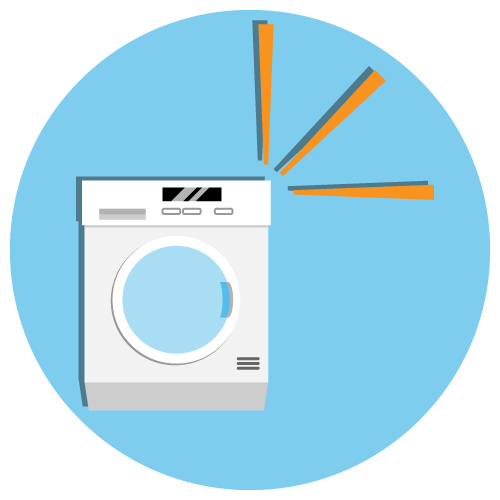
The vast majority of dryers emit an acoustic signal as soon as the end of the programme is reached or the user has to do something, such as empty the condensation container or clean the lint filter. This is particularly advantageous if the appliance is not operated directly in the occupied area but, for example, in the basement.
App control

Some modern dryer models are wi-fi compatible and can thus be integrated into a smart home system. They can then also be controlled via smartphone or tablet apps. In most cases, this makes it possible to switch the appliance on and off, select or change a programme, view the remaining time display and receive a notification when the drying process is complete.
Notes on use and care
In general, it is important to empty the condensation water collection container and clean the lint filter regularly. The door opening area and the area around the rubber seal should also be cleaned from time to time so that any lint that sticks there does not fall onto the fresh laundry. In addition, not all textiles may be put in the dryer. Allergy sufferers should take note of some special information.
Can every item of clothing be put in the dryer?
The answer to this question is clearly no. Some textiles need to be dried particularly gently or do not tolerate the process at all. For this reason, users should consult the washing instructions in the labels of the garments if they are unsure.
Look for a square with a circle in it. This is the dryer symbol. This garment can be put in the tumble dryer.
If this symbol is crossed out, the garment must not be machine dried. Hang it on the clothesline instead.
If there is a dot in the circle, a gentle treatment is required: Only with a manual temperature reduction will these textiles survive the process undamaged.
If there are two symbols in the circle, the garment can be put in the dryer without any special presettings.
Advice for allergy sufferers
A dryer can also be beneficial for allergy sufferers: A lot of pollen is deposited on laundry that has been hung outdoors with residual moisture, and this pollen is present in the ambient air in varying quantities depending on the season. When pollen levels are high, allergy sufferers should therefore use a tumble dryer or clothesline in a room that can be ventilated intermittently.
Differentiation from other types of dryers
In addition to the classic condenser tumble dryer, there are other model variants which we describe below. We also list the advantages and disadvantages of each.
Condenser tumble dryer with heat pump
A more advanced form of the condenser tumble dryer is a device with an integrated heat pump. In common parlance, they are simply referred to as heat pump dryers. In principle, this is a classic condensation dryer. The only difference is that the heat pump dryer uses the residual heat of the moist exhaust air to reheat the new supply air. In this way, after heating the air once, no further or only little energy needs to be used to heat the new supply air.
If used frequently, for example in households with a small child or families with more than two children, the more cost-intensive purchase of a heat pump dryer can pay for itself after some time: If such an appliance is used frequently over the long term, the comparatively low operating costs compensate for the purchase price. The system is energy-saving and therefore good for the wallet and the environment in the long run.
Advantages
- Particularly energy-saving
- Subsequent costs lower than for units without a heat pump
Disadvantages
- Long programme runtime
- Comparatively high purchase price
Exhaust air dryer: Hose severely limits choice of installation location
An exhaust-air dryer is the oldest type of dryer and, unlike condensation dryers, works without a tank for the condensed water. Instead, the warm air produced by the appliance and the exhaust air must be discharged outside via a hose. This is impractical because users can then only place the units near an outside door or window or an exhaust air system. An exhaust air pipe longer than three metres is not recommended, as otherwise there may be problems with discharging the warm, humid air.
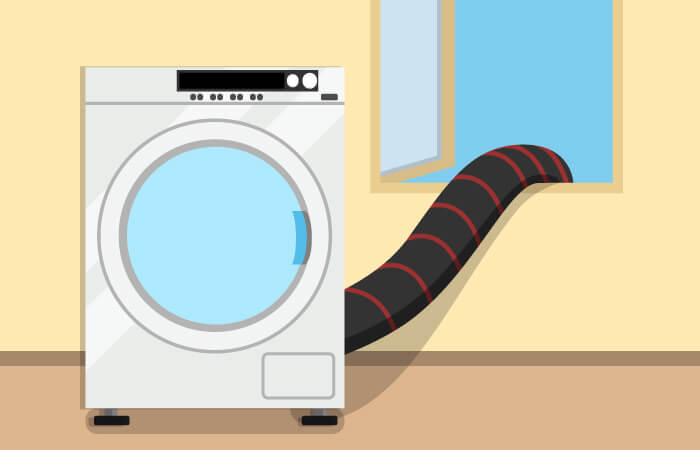
Special installation instructions from the manufacturer must also be observed to prevent condensation from accumulating in the pipe. If there is a fireplace such as a furnace, boiler or gas boiler in the operating room of the exhaust air dryer or in adjacent rooms, the low negative pressure caused by the exhaust air dryer can ensure that the fireplaces do not draw properly. In this case, there is a risk of poisoning from exhaust fumes. For this reason, a supply of fresh air must be ensured for these appliances, for example by an open window in the operating room. If this advice is followed, however, there is no need to worry about problems. However, the comparatively high energy costs mean that condensation and heat-pump dryers are becoming increasingly popular.
Advantages
- Inexpensive to buy
- Short programme runtimes
Disadvantages
- Exhaust air opening such as window or door required
- If there is a direct wall opening for the hose, a window must also be opened to avoid negative pressure
- High electricity costs
Washer-dryer: Save one appliance by combining the washing and drying processes
A washer-dryer is a household appliance that combines the functions of a washing machine and a tumble dryer. Until 2010, all appliances worked on the principle of a condensation dryer. However, since the laundry needs more space in the drum for drying than for washing, users either have to remove part of the clothes after washing and later start the appliance for a second drying, or they already fill the appliance with a lower load during washing. Since the vast majority of appliances require fresh water to condense the moist warm air during the drying process and tend to dry less laundry in one operation, operating costs are comparatively high. For some years now, however, appliances have been on the market that do not require fresh water: They work on the principle of the heat pump dryer. In general, washer-dryers are therefore particularly suitable for households where there is not enough space for two separate appliances. In addition, the household size should not exceed one or two people, otherwise operation quickly becomes uneconomical.
Advantages
- Only one appliance is needed
- Drying process starts directly after washing
Disadvantages
- Longer application time
- Especially older appliances cause high energy costs

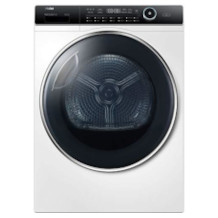
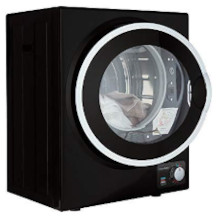
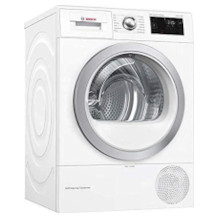
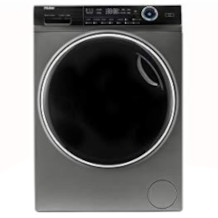
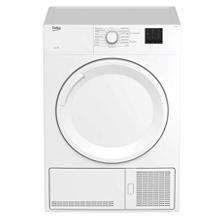
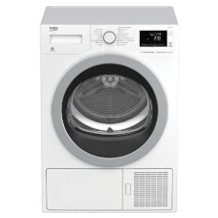

 2,682 reviews
2,682 reviews
